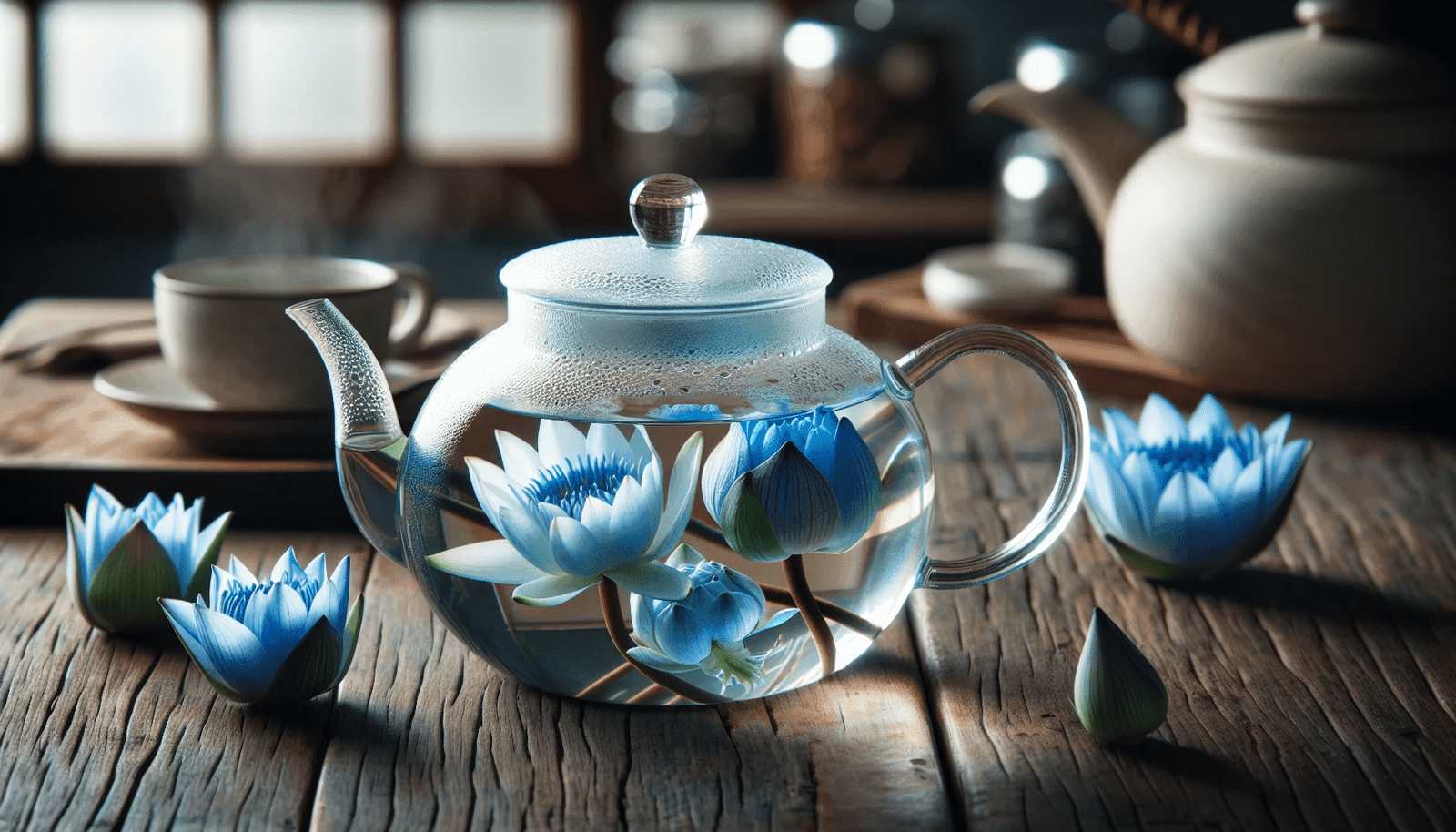Blue Lotus is a mysterious plant with fascinating effects and a history dating back to ancient Egyptian culture. You can use it to prepare Blue Lotus tea or for smoking the Blue Lotus flowers. Discover not only its unique taste, but also a variety of potential health benefits and psychoactive properties. Blue Lotus tea is an amazing drink that has captivated many people for its calming effects and potential for lucid dreaming. Let’s go on a journey to discover the secrets of this fascinating plant and learn how to brew Blue Lotus tea. You’ll also read how to prepare the infamous Blue Lotus wine.
Inhalt
ToggleWhat is Blue Lotus – discovering the Sacred Flower

Blue Lotus is also known as Blue Water Lily, Egyptian Lotus and under its scientific name Nymphaea Caerulea. This aquatic plant originated in ancient Egypt, where it was native to the muddy shallow waters of the Nile River. This plant had great spiritual and cultural significance for the ancient Egyptians. It was used in religious ceremonies and associated with the sun god Ra and the afterlife, which can be seen in numerous works of art and in depictions of various deities. In addition, the Blue Lotus was used recreationally, mainly for its aphrodisiac and mildly psychoactive properties. It was so popular that it was even found in King Tutankhamun’s tomb.
In the history of the Blue Lotus, which spread from Egypt through the Roman Empire to India, the plant was cultivated for its beauty and intoxicating effects. It was used both as a religious sacrament and to promote well-being. After the plant fell into oblivion in antiquity, archaeological discoveries in the 19th century revived interest in it, particularly because of its frequent depictions in ancient tombs.
The fascinating attraction of the Blue Lotus lies in its psychoactive properties, which have led to the consumption of the flower for medicinal as well as spiritual and intoxicating purposes throughout history. Today, Blue Lotus continues to fascinate as a mind-altering beverage, with even hallucinogenic effects and the potential for lucid dreaming attributed to it.
Blue Lotus Flower: Effects
One of the most intriguing aspects of Blue Lotus is its combination of relaxing and stimulating effects. Its psychoactive properties offer a distinctive blend of serenity and invigoration, making it an ideal choice for meditation, yoga, and stress relief. The Blue Egyptian Lotus has been used in traditional medicine for its potential health benefits, such as reducing anxiety and improving sleep. The intensity of the effects depends on the dose, with smaller amounts producing gentler, calming effects, while larger doses produce more intense psychoactive and euphoric experiences.
The effects of the Blue Lotus flower can be attributed to its psychoactive compounds, apomorphine and nuciferin, which interact with the serotonin and dopamine receptors in the brain. As a result, the Blue Lotus flower can relieve anxiety, have a relaxing effect, and promote a sense of well-being.
In addition, Blue Lotus contains over 20 different antioxidants, including phenols, flavonoids, anthocyanins, saponins, and anthraquinones. Due to these antioxidants, Blue Lotus can potentially have a positive effect on your body. Blue Lotus is also popular because many people report an aphrodisiac effect.
Last but not least, the sacred blue lily has also been used as a dream herb for centuries. It is said to intensify dreams and help induce lucid dreams.
The effects of Blue Lotus can have a variety of benefits for your health. Despite the many potential health benefits of Blue Lotus tea, cautious use is important due to its potent psychoactive effects, especially in high doses. There are only few studies that comprehensively investigate the effects of Blue Lotus. Most assumptions about the positive effects of Blue Lotus are therefore anecdotal in nature and relate to positive testimonials from many people. These include:
Anxiety and Stress Relief
The flowers of the Blue Lotus contain ingredients that have a calming effect on the nervous system and can therefore reduce stress and anxiety. This relaxing effect makes the Blue Lotus a popular remedy in various rituals and practices aimed at promoting calm and inner peace.
The traditional use of Blue Lotus is not only about the aesthetic quality of the plant, but also about its profound effect on the mind and body. People suffering from everyday stress often find natural support in the petals of the blue lotus to promote a balance of energy and positive perception.

Sleep Support
Blue Lotus Tea is one of the herbal remedies, that can help people who suffer from sleep problems. Its natural ingredients have a relaxing effect on the body and mind, which makes it easier to fall asleep and contributes to a deeper, more restful sleep. It also enhances dreams. It is best prepared as a tea before going to bed.
Relief from Menstrual Pain
Many users find Blue Lotus tea helpful in relieving menstrual pain. The soothing properties of the plant have a positive effect on the body and can help to alleviate cramp-like pain during menstruation. Taking Blue Lotus in the form of tea or as an extract offers a natural alternative to relieve discomfort and promote general well-being during the menstrual cycle.
Aphrodisiac Effect of Blue Lotus Tea
The Blue Lotus is also used for its aphrodisiac properties. The plant can naturally increase libido and help to intensify the sensual experience. Many value Blue Lotus for its ability to heighten sexual sensation and deepen the emotional connection between partners. It is also said to increase potency.
Blue Lotus Effect on Gastrointestinal Problems
Its calming properties help to alleviate complaints such as dyspepsia and mild indigestion. Taking Blue Lotus, either as a tea or tincture, helps to relax the digestive tract, thereby promoting gentle relief from indigestion.
Relax your Muscles
Blue Lotus is known for its relaxing effect on the muscles. The plant’s ingredients help to relieve muscle tension and contribute to a feeling of physical relaxation. Blue Lotus is therefore also ideal for rituals such as meditation and yoga.
Blue Lotus and Lucid Dreaming

Blue Lotus is often used to promote lucid dreams as it has the potential to improve dream lucidity and promote conscious dreaming. Lucid dreaming refers to a state in which you are aware of your dreams and may even be able to control them. The psychoactive components of Blue Lotus, are used to intensify the dream experience and improve the memory of dreams.
For use in connection with lucid dreaming, Blue Lotus is often consumed as a tea shortly before bedtime. A common dosage is around one to two teaspoons of dried flowers, which are steeped in hot water for five to ten minutes. This amount can be adjusted individually, depending on how intense you want the effect to be. Ideally, the tea should be drunk shortly before sleep to maximize the effect on the dream phases, especially REM sleep.
The exact effects of Blue Lotus on dreaming have not yet been fully researched, but it is believed that the plant’s relaxing and mildly psychoactive properties influence brain activity during sleep, which in turn increases the likelihood of lucid dreaming. This makes Blue Lotus a popular choice for people who want to deepen their dream experiences and gain more control over their dreams.
Blue Lotus Side Effects and Contraindications
Despite the potential health benefits and unique effects that Blue Lotus tea can offer, it is important to be aware of possible side effects and contraindications. There are no reports of overdose with Blue Lotus. There is also no evidence of addictive potential. However, in high doses, Blue Lotus can cause side effects such as hot flushes, mild hallucinations and mild nervousness. To minimize the risk of side effects, it is recommended to start with a low dose of Blue Lotus and gradually increase it over time. Additionally, certain individuals, such as pregnant women or those taking certain medications, should avoid consuming Blue Lotus tea.
How to Make Blue Lotus Tea

The preparation of Blue Lotus tea is very simple. Steep 5 to 10 grams of dried blue lotus flower in a cup of hot water for 10-15 minutes. Blue Lotus tea becomes slightly bitter if steeped for long periods. To improve the taste of the tea, you can add honey or lemon. You can also prepare a Blue Lotus chai by adding spices such as cinnamon, cardamom, cloves or ginger.
The potency of your Blue Lotus tea depends on the amount of flowers used. In general, 5 g of flowers will produce a mild dose, while 10 g will produce a stronger infusion.
Smoking Blue Lotus Flower
When smoking blue lotus flower, you should be careful and only use small amounts. Usually the petals are smoked, either pure or mixed with other herbs. The effects of smoking Blue Lotus can be calming and euphoric, with some people also reporting mild hallucinogenic effects. It is recommended to smoke only the blue petals of the dried Blue Lotus flower and remove the yellow part in the center, also known as the stamen, as this can have a bitter taste and may interfere with the effect. The effects usually kick in within 10-20 minutes of smoking and can last up to a few hours. It is important to note that the effects of smoking Blue Lotus can vary depending on the person and dosage, and that there can also be side effects such as dizziness, nausea and headaches. Therefore, you should be careful and start slowly with a low dosage to see how your body reacts to it. It is also recommended not to smoke Blue Lotus regularly, as the long-term effects have not yet been fully studied.
How to Make Blue Lotus Wine
Blue lotus is said to have the strongest effect when soaked in wine. Alcohol extracts the ingredients particularly well. For Blue Lotus wine, the flowers are soaked in water and then mixed with wine and spices. The drink has a long history and was already used as a sacred drink in ancient Egypt. Blue Lotus wine is often described as an aphrodisiac and mood enhancer and is said to have a calming and euphoric effect.
To make Blue Lotus wine, you need the following ingredients:
- 1 cup dried blue lotus flowers
- 1 bottle of red wine (750 ml). Sweet wines are best, as the lotus can develop a bitter note over time.
- 1 cup honey or sugar
- 1 cinnamon stick
- 1 teaspoon cloves
- 1 teaspoon cardamom
And this is how you make Blue Lotus wine:
- Place the dried flowers in a glass jar and pour the red wine over them.
- Add the honey or sugar, cinnamon stick, cloves and cardamom.
- Close the container and shake well to mix all the ingredients.
- Leave the container in a dark, cool place for at least 2 weeks. Shake it once a day so that the ingredients mix well.
- After 2 weeks, you can pour the wine through a sieve to remove the solids.
- Pour the wine into a bottle and store it in a dark, cool place.
- Blue Lotus wine should be consumed in small quantities as it can have a strong effect. Start with a small amount and wait to see how your body reacts to it.
Other Methods for Consuming Blue Lotus
Apart from smoking Blue Lotus flower and preparing it as a tea, there are numerous other ways to experience the unique effects of the Blue Lotus plant. Options include:
- Vaping (vaporizing): By vaporizing the flower petals of the blue lotus, a gentle effect can be achieved, similar to that of smoking. This method is well suited for a controlled intake and immediate relaxation. You will need a vaporizer for dried herbs. It is important to set the right temperature when vaporizing to preserve the valuable ingredients and avoid burning. Blue lotus vaporizes between 100 and 125 degrees Celsius. Grind the leaves as small as possible.
- Tinctures: Blue Lotus tinctures are highly concentrated and offer rapid absorption of the active ingredients. They are made by soaking the dried flowers in alcohol and are ideal for dosing as required. A few drops under the tongue or mixed into a drink quickly unfolds its calming effect. It is important to start with a small amount to test the individual reaction.
- Edible products: Blue Lotus can be consumed in edible form, such as in pastries or snacks. For this, extracts of the resin or tinctures are mixed into food. This method offers a more subtle and longer-lasting effect, ideal for sustained relaxation over several hours. Dosing should be done carefully as the effects are delayed.
- Bath additive: Blue Lotus can also be used as a bath additive, with the flowers releasing their relaxing properties in hot bath water. This method is excellent for physical relaxation and relieving muscle tension. A Blue Lotus bath can also be used as part of a relaxation ritual before bedtime to calm the mind and improve sleep quality.
Is Blue Lotus Legal?
It is important to be aware of the legal status and possible restrictions regarding the consumption and sale of Blue Lotus in your region. In the United States, Blue Lotus is not classified as a controlled substance under federal law, which means that it is legal to possess, sell, and consume it. However, some states have their own laws regarding Blue Lotus, so it is important to check local regulations before buying or using it. In Canada, Blue Lotus is legal to possess and consume, but it cannot be sold for human consumption. This means that while it is legal to grow and use Blue Lotus for personal use, it is illegal to sell it as a food, drug, or natural health product. In most countries in the European Union Blue Lotus is fully legal. The exceptions are Latvia, Poland, Romania and Russia.
Make sure you familiarize yourself with the legal landscape in your area before getting involved with Blue Lotus or other psychoactive plants.
How to Find Good Quality when you Buy Blue Lotus flowers
Selecting high quality Blue Lotus flowers is crucial to optimize your tea experience and maximize the health benefits. When selecting the flowers, you should pay attention to the following characteristics:
- Color: Fresh petals have an intense bright blue color.
- Aroma: Choose flowers with a sweet, floral scent.Aroma: Choose flowers with a sweet, floral scent.
- Organic quality: Make sure that the retailer offers certified organic Blue Lotus
The use of Blue Lotus (Nymphaea Caerulea) is not very common in the western countries. Therefore, most tea stores do not have it in stock. The best place to buy dried Blue Lotus flower is in online stores.
The Enchanting Taste of Blue Lotus Tea

A tea made from a dried blue lotus low has an unique taste that sets it apart from other herbal teas. It’s mildly sweet, accompanied by a floral fragrance with bitter and earthy notes.
As mentioned above, the taste of blue lotus tea can be enhanced by adding honey or lemon or chai spices.
Summary
Blue Lotus tea is a fascinating elixir with a rich history and a multitude of potential health benefits. You got a Blue Lotus wine and Blue Lotus tea recipe and learned how to smoke Blue Lotus. With all three methods you can benefit from its unique combination of calming and euphoric-psychoactive effects and potential for lucid dreaming. Stepping food in the ancient Egyptian cultural significance makes the beverage even more enticing.Discover the fascinating world of Blue Lotus for yourself and experience the calming as well as mentally stimulating benefits of this historic elixir. click here to purchase high-quality Blue Lotus*.
Frequently asked questions
Blue lotus has been consumed for thousands of years. There are no reports of overdose or addiction. In high doses, mild side effects such as hot flushes, mild hallucinations and nervousness are possible. Allergic reactions, such as itchy skin, have been reported in some people.
In the United States, Blue Lotus is not classified as a controlled substance under federal law, which means that it is legal to possess, sell, and consume it. However, some states have their own laws regarding Blue Lotus, so it is important to check local regulations before buying or using it.
The petals are steeped in hot water for 10 to 15 minutes. Take 5 grams for a mild dosage and 10 grams for a stronger effect.
Blue lotus tea is best prepared at a temperature of 80°C.
Blue lotus tea can help relieve anxiety, promote sleep, relieve menstrual pain and increase libido.

